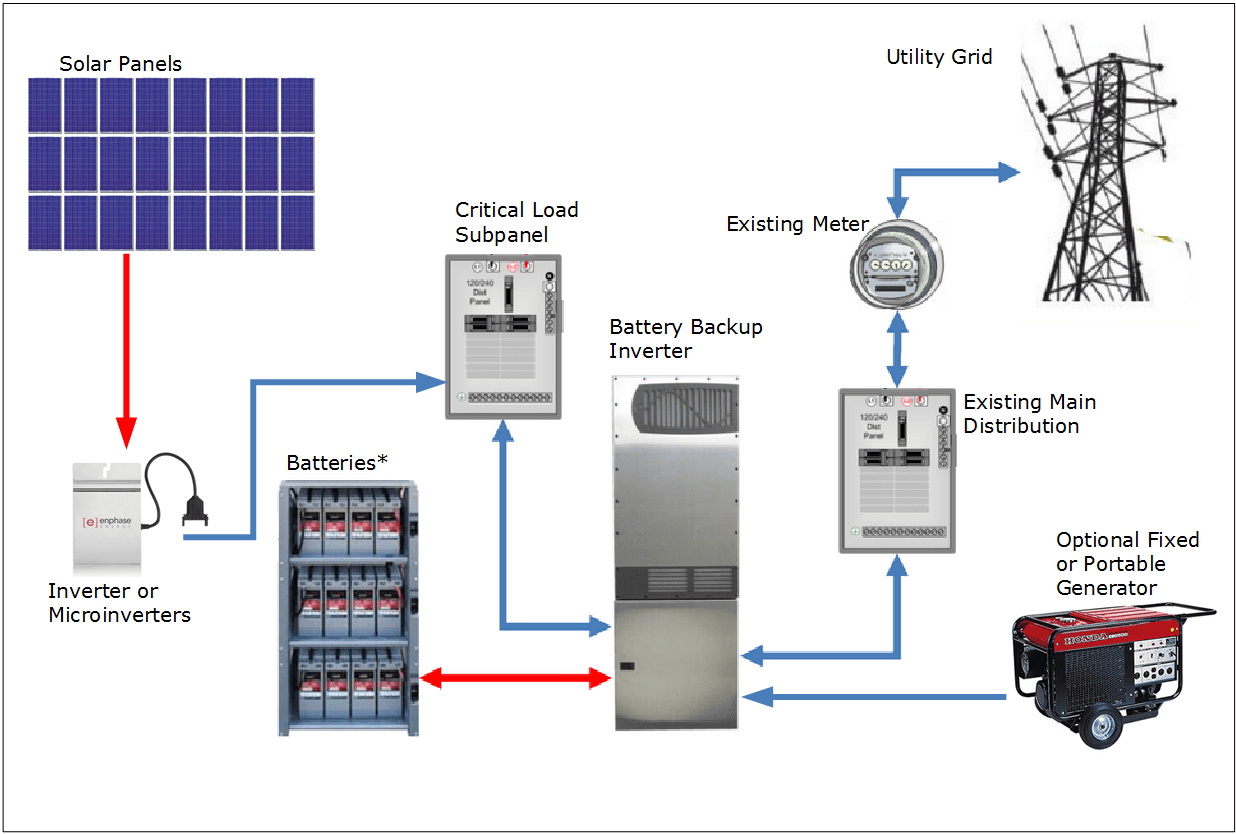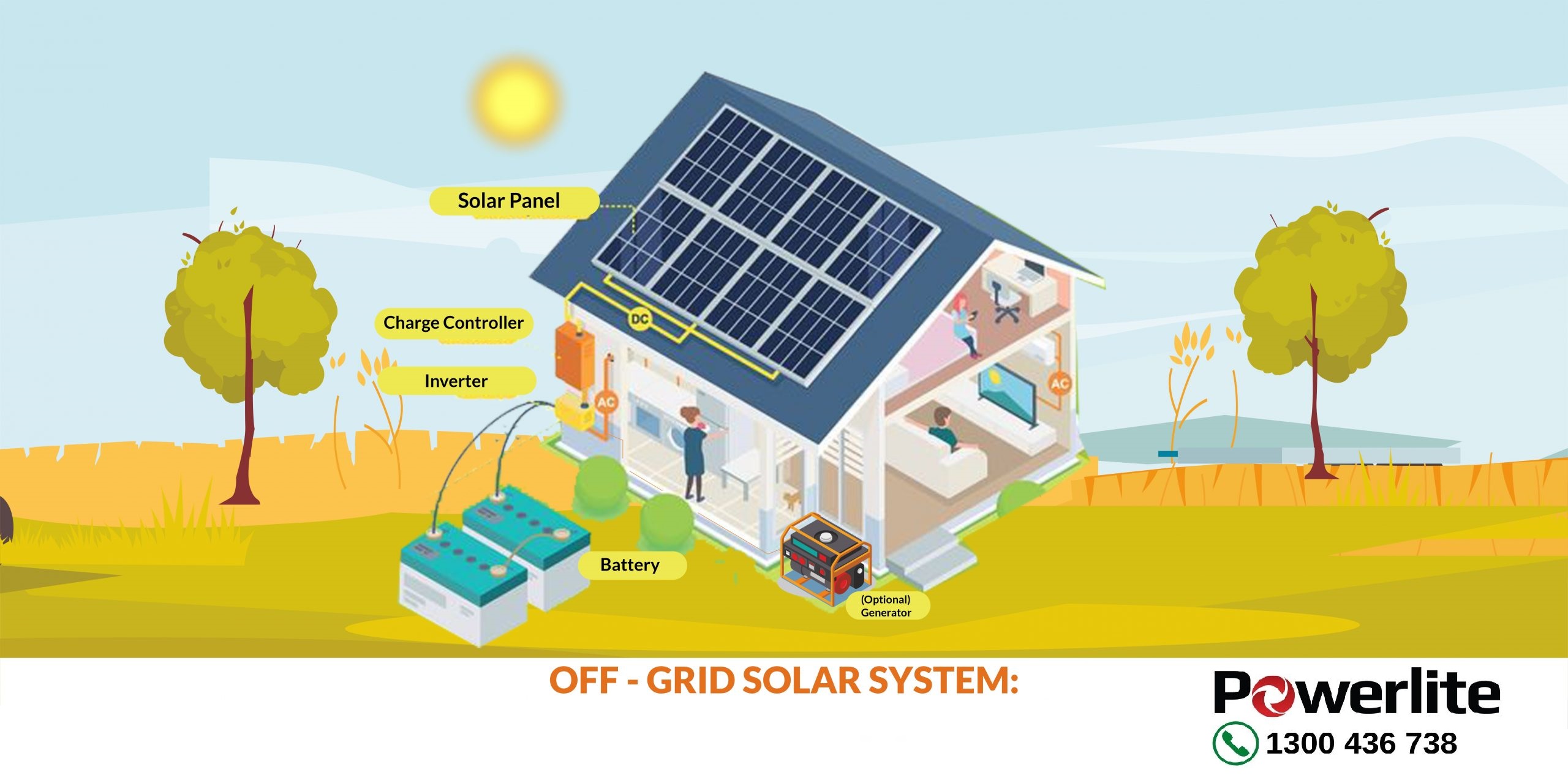Harnessing the sun’s power with off grid solar with generator backup offers a path to energy independence and resilience. This guide delves into the components, installation, maintenance, and benefits of these systems, empowering you to create a sustainable and reliable energy solution for your off-grid living.
From designing and sizing your system to monitoring its performance and ensuring its longevity, we’ll cover every aspect of off grid solar with generator backup, equipping you with the knowledge and confidence to embark on this journey towards energy freedom.
Off-Grid Solar System Design
An off-grid solar system with generator backup is designed to provide electricity to a home or business that is not connected to the electrical grid. The system typically consists of the following components:
- Solar panels: These convert sunlight into electricity.
- Batteries: These store electricity generated by the solar panels.
- Charge controller: This regulates the flow of electricity from the solar panels to the batteries.
- Inverter: This converts the DC electricity from the batteries to AC electricity that can be used by appliances.
- Generator: This provides backup power when the solar panels are not generating enough electricity.
The size of an off-grid solar system will depend on the following factors:
- The amount of electricity you need.
- The amount of sunlight your property receives.
- The efficiency of your solar panels.
- The capacity of your batteries.
- The size of your generator.
Types of Solar Panels
There are two main types of solar panels: monocrystalline and polycrystalline. Monocrystalline solar panels are made from a single crystal of silicon, while polycrystalline solar panels are made from multiple crystals of silicon. Monocrystalline solar panels are more efficient than polycrystalline solar panels, but they are also more expensive.
| Type of Solar Panel | Efficiency | Cost |
|---|---|---|
| Monocrystalline | 15-20% | $250-$400 per panel |
| Polycrystalline | 13-17% | $150-$300 per panel |
Types of Generators
There are two main types of generators: portable and standby. Portable generators are designed to be used for short periods of time, while standby generators are designed to provide backup power for longer periods of time. Portable generators are typically less expensive than standby generators, but they are also less powerful.
Obtain a comprehensive document about the application of off the grid living illegal that is effective.
| Type of Generator | Power Output | Cost |
|---|---|---|
| Portable | 2,000-5,000 watts | $300-$1,000 |
| Standby | 5,000-10,000 watts | $1,000-$3,000 |
Installation and Maintenance
Off-grid solar systems with generator backup require proper installation and maintenance to ensure optimal performance and longevity.
Installation, Off grid solar with generator backup
1. Site Assessment
Determine the location, size, and orientation of the solar panels based on sunlight exposure and roof space.
2. Mounting
You also will receive the benefits of visiting 2000 watt off grid solar system today.
Securely mount the solar panels on the roof using appropriate brackets and hardware.
3. Wiring
Connect the solar panels to the charge controller, batteries, and inverter using appropriate wiring and connectors.
4. Generator Integration
Connect the generator to the system’s transfer switch, which will automatically switch between solar and generator power as needed.
Maintenance
1. Solar Panels
Regularly clean the solar panels to remove dust, debris, and bird droppings.
2. Batteries
Monitor battery health, charge levels, and electrolyte levels. Replace batteries as needed.
3. Generator
Perform regular maintenance, including oil changes, filter replacements, and spark plug checks.
Safety Precautions
When working with electrical systems, always follow these safety precautions:* Wear proper safety gear (gloves, safety glasses).
- Disconnect power before working on any components.
- Use insulated tools and avoid touching exposed wires.
- Ground all equipment properly.
Energy Storage and Backup
Energy storage and backup are crucial components of off-grid solar systems. Batteries store excess solar energy generated during the day for use at night or during periods of low sunlight. Generators, on the other hand, provide backup power when the battery is depleted or during extended periods of inclement weather.
Types of Batteries for Off-Grid Solar Systems
Various types of batteries are available for off-grid solar systems, each with its advantages and disadvantages. The most common types include:
- Lead-acid batteries: These are the most affordable and widely used type of battery for off-grid solar systems. However, they have a relatively short lifespan and require regular maintenance.
- Lithium-ion batteries: These batteries are more expensive than lead-acid batteries, but they have a longer lifespan and require less maintenance. They are also more lightweight and compact.
- Flow batteries: These batteries are relatively new to the market and offer several advantages over lead-acid and lithium-ion batteries. They have a longer lifespan, are more efficient, and can be scaled up to larger capacities.
The choice of battery type depends on factors such as budget, energy requirements, and desired lifespan.
| Battery Type | Pros | Cons |
|---|---|---|
| Lead-acid | Affordable, widely available | Short lifespan, requires regular maintenance |
| Lithium-ion | Long lifespan, low maintenance, lightweight | Expensive |
| Flow | Long lifespan, efficient, scalable | Relatively new, expensive |
Role of Generators in Off-Grid Solar Systems
Generators provide backup power to off-grid solar systems when the battery is depleted or during extended periods of inclement weather. They can be powered by gasoline, diesel, or propane. The size of the generator required depends on the energy requirements of the system.
Generators are an essential component of off-grid solar systems, as they ensure a reliable supply of electricity even when the sun is not shining.
System Monitoring and Control
Off-grid solar systems require careful monitoring to ensure optimal performance and energy efficiency. There are various methods for monitoring system performance, including:
Data Logging and Analysis
Data loggers collect and store system data, such as energy generation, consumption, and battery status. This data can be analyzed to identify trends, diagnose problems, and optimize system performance.
Remote Monitoring Systems
Remote monitoring systems allow users to monitor their off-grid solar system remotely via the internet. These systems provide real-time data, alerts, and remote control capabilities, enabling users to make informed decisions and respond to system issues promptly.
Learn about more about the process of best off grid solar panels in the field.
Load Management and Energy Conservation
Load management and energy conservation are crucial in off-grid systems to ensure the efficient use of available energy. Load management strategies include prioritizing essential loads, shedding non-essential loads during peak demand, and using energy-efficient appliances. Energy conservation measures involve reducing energy consumption through insulation, efficient lighting, and behavioral changes.
Economic and Environmental Considerations: Off Grid Solar With Generator Backup
Installing an off-grid solar system with generator backup can provide significant financial and environmental benefits. The initial investment in the system can be substantial, but the long-term savings on energy costs can make it a worthwhile investment.
Obtain access to best off the grid books to private resources that are additional.
Financial Benefits
The financial benefits of an off-grid solar system with generator backup include:
- Reduced electricity bills: Solar panels can generate electricity for free, reducing or eliminating the need to purchase electricity from the grid.
- Increased property value: Homes with off-grid solar systems are often more valuable than homes without them.
- Government incentives: Many governments offer tax credits and rebates for the installation of solar panels.
Cost Comparison
The cost of an off-grid solar system with generator backup will vary depending on the size of the system and the components used. The following table provides a general comparison of the cost of different system configurations:
| System Size | Cost |
|---|---|
| 1 kW | $5,000
|
| 2 kW | $10,000
|
| 3 kW | $15,000
|
Environmental Benefits
Using renewable energy sources, such as solar power, has a number of environmental benefits, including:
- Reduced greenhouse gas emissions: Solar panels do not produce greenhouse gases, which contribute to climate change.
- Reduced air pollution: Solar panels do not produce air pollution, which can cause respiratory problems and other health issues.
- Reduced water consumption: Solar panels do not require water to operate, unlike fossil fuel-powered generators.
End of Discussion
Off grid solar with generator backup is not just a technological solution; it’s a gateway to energy independence and environmental stewardship. By embracing this technology, you not only reduce your reliance on fossil fuels but also contribute to a cleaner and more sustainable future.
Embrace the power of the sun and the peace of mind that comes with having a reliable backup, and experience the transformative benefits of off grid solar with generator backup.
FAQ Summary
What are the main components of an off grid solar system with generator backup?
The key components include solar panels, charge controller, batteries, inverter, and generator.
How do I determine the right size of an off grid solar system?
Consider your energy consumption, sunlight availability, and desired level of backup power.
What are the advantages of using batteries in an off grid solar system?
Batteries store excess solar energy for use during periods of low sunlight or high energy demand.


